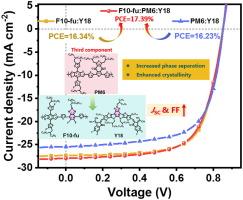Modulation of phase separation and molecular stacking in ternary organic solar cells by introducing a guest polymer with excellent miscibility with host polymer
IF 13.3
1区 工程技术
Q1 ENGINEERING, CHEMICAL
引用次数: 0
Abstract
Proper miscibility between polymer donor and nonfullerene acceptor (NFA) to form a desired photoactive layer morphology is one of the key prerequisites to achieving efficient organic solar cells (OSCs). The ternary strategy provides a straightforward and effective approach for adjusting the miscibility of different components. For benzo [d][1,2,3] triazole (BTA) −based polymers, their photovoltaic properties largely lag behind those of other classical polymers. We tried different kinds of small molecule receptors as the third component, but the results were not satisfactory, and then focused the selection of the third component on the polymer donor. In this study, we incorporated the wide-band gap polymer PM6 as a guest polymer to the F10-fu:Y18 combination, both of which contain BTA unit. PM6 is preferentially miscible with F10-fu, and the addition of PM6 reduces the miscibility of the donor materials with Y18. This adjustment allows simultaneous optimization of phase separation and molecular stacking, leading to the formation of nanoscale charge transport channels. Consequently, the power conversion efficiency (PCE) of F10-fu:PM6:Y18-based ternary device reached 17.39%, obviously higher than that of F10-fu:Y18-based binary device (16.34%) and PM6:Y18-based binary device (16.23%). These improvements can be attributed to extended light absorption range, cascade energy levels, superior morphology, and favorable charge dynamics. Our study offers guidance for the regulation mechanism of ternary OSCs driven by miscibility based on two donor polymers/ one acceptor molecule system.

聚合物供体和非富勒烯受体(NFA)之间适当的混溶以形成理想的光活性层形态,是实现高效有机太阳能电池(OSC)的关键先决条件之一。三元策略为调整不同成分的混溶性提供了一种直接有效的方法。对于苯并[d][1,2,3]三唑(BTA)基聚合物来说,它们的光伏特性在很大程度上落后于其他经典聚合物。我们尝试了不同种类的小分子受体作为第三组分,但效果并不理想,于是将第三组分的选择重点放在了聚合物供体上。在这项研究中,我们将宽带隙聚合物 PM6 作为客体聚合物加入到 F10-fu:Y18 组合中,这两种聚合物都含有 BTA 单元。PM6 优先与 F10-fu 混溶,而 PM6 的加入降低了供体材料与 Y18 的混溶性。这种调整可同时优化相分离和分子堆积,从而形成纳米级电荷传输通道。因此,基于 F10-fu:PM6:Y18 的三元器件的功率转换效率(PCE)达到了 17.39%,明显高于基于 F10-fu:Y18 的二元器件(16.34%)和基于 PM6:Y18 的二元器件(16.23%)。这些改进可归因于扩大的光吸收范围、级联能级、优异的形态和有利的电荷动力学。我们的研究为基于两个供体聚合物/一个受体分子体系的混溶驱动的三元 OSC 的调节机制提供了指导。
本文章由计算机程序翻译,如有差异,请以英文原文为准。
求助全文
约1分钟内获得全文
求助全文
来源期刊

Chemical Engineering Journal
工程技术-工程:化工
CiteScore
21.70
自引率
9.30%
发文量
6781
审稿时长
2.4 months
期刊介绍:
The Chemical Engineering Journal is an international research journal that invites contributions of original and novel fundamental research. It aims to provide an international platform for presenting original fundamental research, interpretative reviews, and discussions on new developments in chemical engineering. The journal welcomes papers that describe novel theory and its practical application, as well as those that demonstrate the transfer of techniques from other disciplines. It also welcomes reports on carefully conducted experimental work that is soundly interpreted. The main focus of the journal is on original and rigorous research results that have broad significance. The Catalysis section within the Chemical Engineering Journal focuses specifically on Experimental and Theoretical studies in the fields of heterogeneous catalysis, molecular catalysis, and biocatalysis. These studies have industrial impact on various sectors such as chemicals, energy, materials, foods, healthcare, and environmental protection.
 求助内容:
求助内容: 应助结果提醒方式:
应助结果提醒方式:


